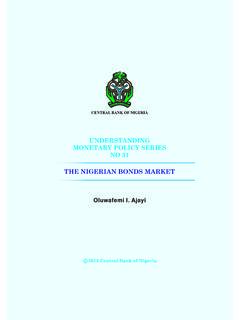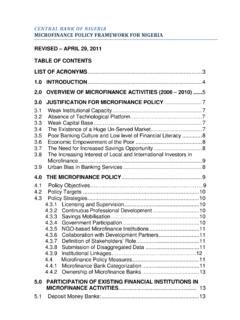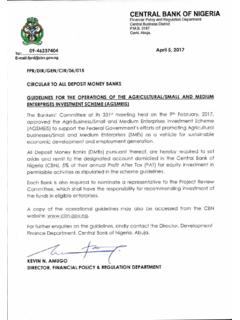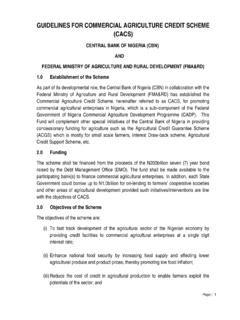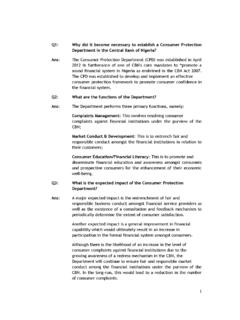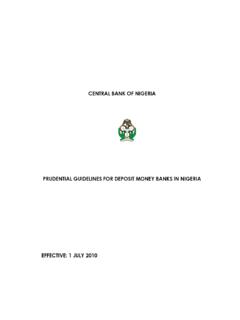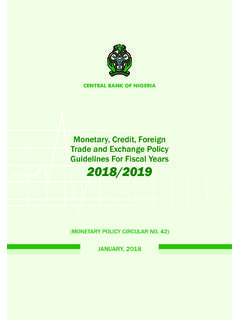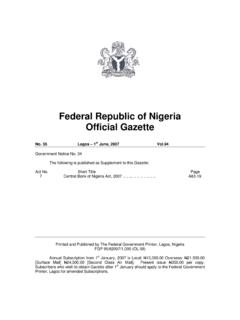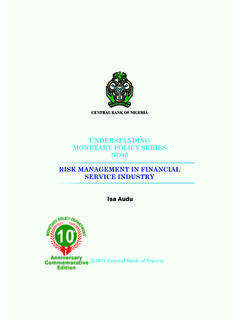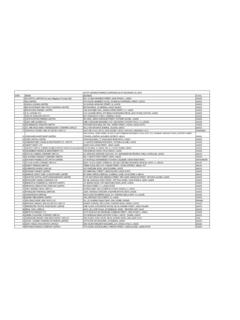Transcription of ISSN 1957-2968 CENTRAL BANK OF NIGERIA
1 CENTRAL bank OF NIGERIA Institutions, Natural Resources and Economic Growth: An Application of Co-integration with Structural Break on Nigerian Dataset Garba T., Bello U., Abdullahi H. and Abubakar M. Quantifying the Macroeconomic Impact of Trade Liberalisation in NIGERIA Shuaibu M. Investigating the Relationship between Broad Money Velocity, Inflation and Nominal Output Growth in NIGERIA Adenekan A. Does Cash Reserve Requirement (CRR) influence bank Lending in NIGERIA ? Penzin, D. J., Nkang N. M. and Okafor H. O. Economic and Financial Review Volume 54, Number 4 December 2016 ISSN 1957-2968 INSERT CBN LOGO Editorial Committee Editor-in-Chief Uwatt B. Uwatt Managing Editor Editor Deputy Editor Associate Editors Editorial Assistants Copyright 2016 CENTRAL bank of NIGERIA ISSN 1957-2968 CENTRAL bank of NIGERIA Economic and Financial Review Volume 54, Number 4, December 2016 Aims and Scope The Economic and Financial Review is published four times a year in March, June, September and December by the Research Department of the CENTRAL bank of NIGERIA .
2 The Review contains articles on research undertaken at the bank , in particular, and NIGERIA , in general, mainly on policy issues both at the macroeconomic and sectoral levels in the hope that the research would improve and enhance policy choices. Its main thrust is to promote studies and disseminate research findings, which could facilitate achievement of these objectives. Comments on or objective critiques of published articles are also featured in the review. Correspondence Correspondence regarding the Economic and Financial Review and published articles should be addressed to: Director of Research/Editor-in-Chief CBN Economic and Financial Review CENTRAL bank of NIGERIA 33 Tafawa Balewa Way CENTRAL Business District P. M. B. 0187 Garki Abuja NIGERIA Email: Website: Subscription Subscription to the CENTRAL bank of NIGERIA Economic and Financial Review is available without charge to institutions, corporations, embassies, and development agencies.
3 Individuals can send written request for any particular edition of interest, also without charge. Articles may be reprinted, reproduced, published, abstracted, and distributed in their entirety on condition that the author and the source CENTRAL bank of NIGERIA Economic and Financial Review are duly credited. Disclaimer Any opinions expressed in the Economic and Financial Review are those of the individual authors and should not be interpreted to represent the views or policies of the CENTRAL bank of NIGERIA , its Board of Directors or its Management. Notes to Contributors Information on manuscript submission is provided on the last and inside back cover of the Review. CENTRAL bank of NIGERIA Economic and Financial Review Volume 54/4 December 2016 Contents Institutions, Natural Resources and Economic Growth: An Application of Co-integration with Structural Break on Nigerian Dataset Garba T.
4 , Bello U., Abdullahi H. and Abubakar M.. 1 Quantifying the Macroeconomic Impact of Trade Liberalisation in NIGERIA Shuaibu M.. Investigating the Relationship between Broad Money Velocity, Inflation and Nominal Output Growth in NIGERIA Adenekan A.. Does Cash Reserve Requirement (CRR) influence bank Lending in NIGERIA ? Penzin, D. J., Nkang N. M. and Okafor H. O.. CENTRAL bank of NIGERIA Economic and Financial Review Volume 54/4 December 2016 1 Institutions, Natural Resources and Economic Growth: An Application of Co-integration with Structural Break on Nigerian Dataset Garba T., Bello U., Abdullahi H. and Abubakar M. Abstract This study examines the long-run influence of institutions and natural resources on economic growth in NIGERIA over the period 1960 2014. It is apparent that the Nigerian economy depends largely on natural resources such as petroleum products for its sustainance. An economy with good institutions is more likely to use natural resources optimally, and hence that should translate into sustainable economic growth.
5 In view of this, good institutions are required to restore confidence in the economy and ensure adequate management of the natural resources and distribution of the proceeds realised from them. To achieve the objectives of this study, Gregory & Hansen s (1996a) co-integration approach and vector error correction model have been applied. The results reveal that institutions have a significant positive long-run influence on economic growth in NIGERIA . Similarly, natural resources have a significant positive long-run relationship with economic growth in NIGERIA . The results thus imply that improving the quality of institutions has the tendency of increasing long-run economic growth in NIGERIA . Furthermore, they imply that enhancing the exploitation and maximum utilisation of natural resources will also help promote long-run economic growth in NIGERIA . In addition, the findings of this study indicate that accounting for structural break in VECM improves the significance and thus, reliability of the model applied.
6 Therefore, this study recommends the enforcement of rule of law which will ensure equality before the law and promote contract enforcement and property rights, which are proxies for institutions. Furthermore, it recommends that government should further enhance the exploitation and maximum utilisation of natural resources as well as diversify the economy so as to reap the benefits from the production of natural resources. Keywords: Institutions, natural resources, economic growth, co-integration, VECM, structural break. JEL Classification Numbers: C32, E02, O43, O55, Q33 I. Introduction rowth theory has been an interesting field of study that has continued to receive the attention of many researchers. Scholars and policy makers have been exploring the field of economic growth in order to help improve its prospects in different economies. Economic growth is, therefore, considered as crucial for the survival and development of different countries.
7 As a result, the investigation of different factors that determine growth has received the attention of many researchers (Acemoglu, 2009; Barro & Sala-i-Martin, 2004; Farmer, 1997). Several factors determine economic growth of a country. Acemoglu (2009) classifies the determinants of economic growth into two broad classes, namely, proximate and the fundamental determinants. He observes that the proximate determinants of economic growth include physical capital, human capital and technology. But the fundamental determinants of economic growth include institutions and natural resources, among others (Acemoglu, 2009). This study, therefore, aims at investigating the influence of these fundamental determinants of economic growth (institutions and natural resources) on the Prof. Tukur Garba and Prof. Hussainatu Abdullahi are staff of the Department of Economics, Faculty of Social Science, Usmanu Danfodiyo University Sokoto; Dr.
8 Musa Y. ABUBAKAR, is of the Department of Accounting, Faculty of Management Sciences, Usmanu Danfodiyo University Sokoto and Umar M. Bello is of the Department of Economics, Federal University Lafia, Nasarawa State. The paper has been extracted from Economics dissertation of the second author supervised by the other authors The views expressed in this paper are those of the authors and do not necessarily reflect the opinions of the CENTRAL bank of NIGERIA . G Garba et. al.,: Institutions, Natural Resources and Economic Growth 2 growth of the Nigerian economy. Eicher, Garcia-Penalosa, & Teksoz (2006) argue that the impact of institutions on growth is through accumulation of physical capital, such as natural resources. Similarly, Gylfason and Zoega (2006) opine that natural resources are an essentially exogenous factor that can affect economic growth through macroeconomic channels as well as through institutions.
9 In view of this, the proxy for natural resources will serve as a mediating variable between institutions and economic growth. Furthermore, it is apparent that that Nigerian economy depends largely on natural resources such as petroleum products for its sustenance, until recently. An economy with good institutions is more likely to use natural resources optimally and hence that should translate into economic growth. Therefore, good institutions are required to restore confidence in the economy and ensure adequate management of the natural resources and distribution of their proceeds. Institutions are rules that guide human interactions (North, 1990). As rules that guide social interactions within societies, institutions could promote productivity. Hall and Jones (1999) observe that institutions protect output from diversion thus promoting growth. Therefore, good institutions may promote productivity and growth.
10 This study considers that institutions may have a significant positive relationship with economic growth. Furthermore, some natural resources are not found everywhere. They are sporadic across the globe. Thus, they become object of trade among nations in their possession with those in need of them. Therefore, countries with large deposits of highly demanded natural resources may have huge income for growth and development. Sachs and Warner (1999) observe that natural resources boom could serve as a big push to the natural resources abundant countries. However, they empirically find that for the natural resources rich countries, periods of resources boom are often followed by slow growth, and in some cases, no growth at all. Nevertheless, the focus of growth theory empirical research on institutions is quite a recent phenomenon (Dawson, 2007). Theoretically, however, studies on the links between institutions and growth could trace their roots to the works of North and Thomas (1973) and North (1990).
